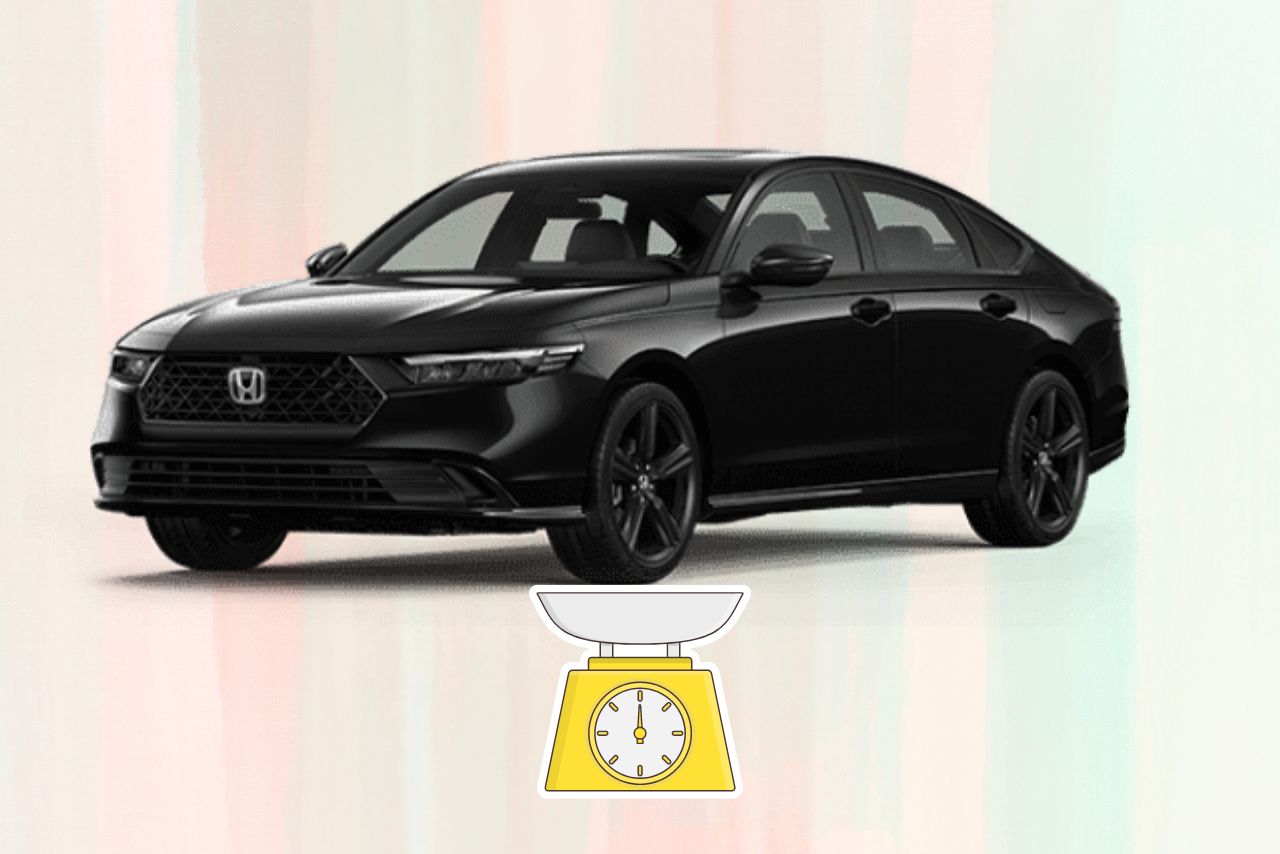Are you interested in purchasing a Honda Accord? One important factor to consider is the weight of the vehicle. Understanding the weight of a car can have implications on its performance, fuel efficiency, and safety.
In this article, we will provide you with a detailed overview of How Much Does A Honda Accord Weigh? by model year, and the factors that affect its weight.
The weight of the Accord can vary depending on the model and year, but generally falls within the range of 3,100 to 3,600 pounds.
The Honda Accord is a popular midsize sedan known for its reliability and practicality. As a potential buyer, you want to make an informed decision when choosing a car that fits your needs and preferences.
By knowing the weight of the Honda Accord, you can determine if it is suitable for your lifestyle and driving habits.
Whether you plan to use it for commuting, traveling, or family outings, the weight of the car can have an impact on your driving experience. So, let’s dive into the world of Honda Accord weight and discover what you need to know.
As of my knowledge cutoff in September 2021, the weight of a Honda Accord typically ranges from around 3,100 pounds (1,406 kilograms) for the base trim to approximately 3,600 pounds (1,633 kilograms) for higher trim levels with additional features.
The weight of a Honda Accord can vary depending on the specific model, trim level, and optional features.
It is important to note that these weights are approximate and may vary slightly depending on the model year and specific configuration of the vehicle.
Table of contents
Understanding Vehicle Weight:

If you’re a car enthusiast, you know that the weight of a vehicle can make a world of difference when it comes to handling and performance.
It’s not just about the power of the engine or the features of the car, but also about the weight distribution and overall mass.
Here are some important things to understand about the importance of vehicle weight and its impact on performance and handling:
-
Vehicle weight affects acceleration: The heavier the vehicle, the slower it will be to accelerate. This is because the engine has to work harder to move the weight of the car. A lighter car, on the other hand, will be able to accelerate faster.
-
Vehicle weight affects braking distance: The heavier the vehicle, the longer it will take to come to a complete stop. This is because the brakes have to work harder to slow down the weight of the car. A lighter car, on the other hand, will have a shorter braking distance.
-
Vehicle weight affects fuel efficiency: The heavier the vehicle, the more fuel it will consume. This is because the engine has to work harder to move the weight of the car, which requires more fuel. A lighter car, on the other hand, will be more fuel-efficient.
-
Vehicle weight affects handling: The weight distribution of a vehicle can affect its handling. A car that is too front-heavy or rear-heavy will not handle as well as a car with a more balanced weight distribution.
Understanding how vehicle weight affects performance and handling can help you make informed decisions when purchasing a car.
It’s not just about the bells and whistles, but also about the weight of the car and how it will impact your driving experience.
Honda Accord Weight by Model Year:
| Year | Model | Engine | Transmission | Curb Weight (lbs) |
|---|---|---|---|---|
| 1990 | DX | 2.0L I4 | Manual | 2,738 |
| 1990 | DX | 2.0L I4 | Automatic | 2,804 |
| 2016 | V6-L | 3.5L V6 | Automatic | 3,675.1 |
| 2020 | LX | 1.5L I4 | CVT | 3,131 |
| 2020 | Hybrid | 2.0L I4 + electric motor | CVT | 3,327 |
| 2023 | LX | 1.5L I4 | CVT | 3,239 |
| 2023 | Hybrid | 2.0L I4 + electric motor | CVT | 3,280 |
If you’re interested in knowing the weight of a Honda Accord by model year, then you’ll want to take a closer look at the First Generation (1976-1981), Second Generation (1982-1985), Third Generation (1986-1989), Fourth Generation (1990-1993), and Fifth Generation (1994-1997).
Each of these generations comes with its own unique weight specifications, so it’s important to pay attention to the details if you’re looking to buy or sell a Honda Accord from one of these model years.
By understanding the weight of each generation, you’ll be better equipped to make an informed decision about which Honda Accord is right for you.
First Generation (1976-1981):
When you’re looking for the weight of a first generation Honda Accord, you’ll find that it ranges from 2,100 to 2,200 pounds depending on the model and year.
This lightweight construction was a key factor in the car’s impressive fuel economy, which was around 30 miles per gallon on the highway.
The first generation Accord was also notable for its sleek design features, which included a low hood line, flush-mounted glass, and a sporty profile.
In addition to its fuel efficiency and stylish design, the first generation Accord was known for its reliability and durability.
Its lightweight construction and efficient engine made it a popular choice for commuters and families alike, and many drivers found that it held up well even after several years of use.
Whether you’re looking for a classic car to restore or a practical vehicle for daily use, the first generation Honda Accord is a great choice that will serve you well for years to come.
Second Generation (1982-1985):
The 80s saw the birth of the ‘digital age’ and the second generation of the Accord embraced this with its electronic digital dashboard.
But it was not just about technology. The Honda Accord underwent design changes to make it more aerodynamic and fuel-efficient.
In fact, the second generation Accord was 10% more fuel-efficient than its predecessor.
Performance capabilities of the second generation Accord were also improved with a larger 1.8-liter engine and a five-speed manual or automatic transmission. The car’s weight was 2,250 lbs for the sedan and 2,400 lbs for the hatchback.
The table below summarizes the key design and performance features of the second generation Accord.
| Design Changes | Performance Capabilities |
|---|---|
| Aerodynamic shape | 1.8-liter engine |
| Fuel-efficient | Five-speed manual or automatic transmission |
| Weight: 2,250 lbs (sedan) and 2,400 lbs (hatchback) |
Overall, the second generation Honda Accord was a significant improvement over the first generation.
The car’s design changes and performance capabilities set a new standard for midsize sedans and solidified the Accord’s position as one of the best-selling cars in its class.
Third Generation (1986-1989):
With its sleek and streamlined body, the third generation Accord exuded a sense of speed and sophistication.
It was slightly larger than its predecessor, with a length of 181.5 inches, a width of 66.9 inches, and a height of 53.1 inches.
But what made the third gen Accord stand out was its weight distribution. The engineers at Honda worked hard to improve the handling performance of the third gen Accord.
They achieved this by placing the engine and transmission in a transverse position, which allowed for better weight distribution. The result was a car that felt more balanced and responsive on the road.
The third generation Accord weighed between 2,500 and 2,900 pounds, depending on the trim level and options.
Overall, the third gen Accord was a significant improvement over its predecessor, and its weight distribution played a crucial role in its improved handling performance.
Fourth Generation (1990-1993):
As you step inside the fourth generation Honda Accord, you’ll feel like you’re sitting in a cockpit, with its driver-focused dashboard resembling a fighter jet’s cockpit.
This generation of Accord was introduced in 1990 and was the first to feature a double wishbone suspension system, which improved handling and ride quality.
It also had a longer wheelbase and wider track, making it more stable on the road.
Understanding the specifications of the fourth generation Accord will help you appreciate the historical changes that Honda made to improve the vehicle. The weight of this model varied depending on the trim level and options, but the base model weighed around 2,800 pounds.
The Accord’s overall length increased from the previous generation, measuring at 184.8 inches, and its width expanded to 67.9 inches.
The fourth generation Accord was a significant improvement over its predecessor and set the standard for future Honda vehicles.
Fifth Generation (1994-1997):
Entering the fifth generation Honda Accord, you’ll notice the sleeker design with a more aerodynamic body shape and a longer wheelbase for increased stability on the road.
This generation offered a more refined driving experience with improved performance specifications.
Here are some design features that make the fifth generation Honda Accord stand out:
- The front grille was redesigned with three horizontal bars, giving it a more contemporary look.
- The Accord had a longer wheelbase, increased by 2.2 inches, which improved its stability and handling.
- The fifth generation also featured a more spacious cabin, with more legroom for passengers.
- The exterior was more aerodynamic, which improved fuel efficiency and reduced wind noise.
- The fifth generation Honda Accord had a more powerful engine, with a 2.2-liter four-cylinder engine that produced 130 horsepower.
Overall, the fifth generation Honda Accord was a significant upgrade from its predecessor, with a more modern design and improved performance specifications. Its sleeker, more aerodynamic body shape and longer wheelbase made it a more stable and comfortable ride.
The improved engine and spacious cabin made it a popular choice for both families and commuters.
Sixth Generation (1998-2002):
You can’t believe how amazing the sixth generation Honda Accord is! It has an advanced V6 engine and luxury features that will make you feel like you’re driving a high-end sports car.
This generation of the Accord was produced from 1998 to 2002 and was available in both coupe and sedan body styles.
The design features of the sixth generation Accord were sleek and modern, with a more aerodynamic shape than its predecessor.
The headlights were rounded and the grille was wider, giving the car a more aggressive look. Inside, the Accord boasted a spacious cabin with comfortable seating and a user-friendly dashboard.
The dimensions of the sedan were 189.4 inches in length, 70.3 inches in width, and 56.1 inches in height, while the coupe was slightly shorter at 186.8 inches in length.
This generation of the Accord was praised for its reliability, performance, and overall value, making it a popular choice for car buyers.
Seventh Generation (2003-2007):
If you’re in the market for a stylish and reliable midsize car, consider checking out the seventh generation Accord, which was produced from 2003 to 2007.
This generation of Accord was available in both sedan and coupe body styles, and boasted a sleek and modern design that set it apart from its predecessors.
The Accord’s exterior featured sharp lines and a low-slung profile, giving it a sporty and aggressive appearance. Inside, the car was spacious and comfortable, with plenty of room for both passengers and cargo.
When it comes to fuel efficiency, the seventh generation Accord was an impressive performer.
The base model, which was equipped with a 2.4-liter four-cylinder engine, earned an EPA-estimated 26 mpg in the city and 34 mpg on the highway.
The higher-end V6 models were slightly less efficient, with ratings of 21 mpg city and 30 mpg highway.
Overall, the seventh generation Accord was an excellent choice for anyone looking for a car that offered both style and fuel efficiency.
Eighth Generation (2008-2012):
Now that you know how much the seventh generation Honda Accord weighs, let’s move on to the eighth generation.
This model was produced from 2008 to 2012 and carries a few key differences from its predecessor.
Firstly, the eighth generation Honda Accord has impressive fuel economy, with an EPA rating of up to 34 miles per gallon on the highway. This is due in part to the car’s relatively light weight, which ranges from 3,200 to 3,500 pounds depending on the specific model and features.
Additionally, the eighth generation Accord is a popular choice for performance tuning enthusiasts due to its responsive engine and well-balanced suspension system.
With the right modifications, this car can easily be transformed into a high-performing driving machine.
Ninth Generation (2013-2017):
Get ready to experience the next level of Honda engineering with the ninth generation Accord. This model boasts improved technology and sleek design, making it a top choice for car enthusiasts.
The ninth generation offers impressive fuel economy, reaching up to 36 MPG on the highway. This allows for more extended drives without the worry of stopping for gas.
In addition to its fuel efficiency, the ninth generation Accord also boasts impressive performance.
Equipped with a standard 2.4-liter four-cylinder engine, this model produces up to 185 horsepower. For those looking for a bit more power, the optional 3.5-liter V6 engine delivers up to 278 horsepower.
The ninth generation Accord’s performance makes it a top contender in its class, offering drivers a comfortable and efficient ride.
Tenth Generation (2018-2022):

The tenth generation of the Honda Accord, which has been in production since 2018, boasts impressive fuel economy and an array of design features that make it one of the most sought-after sedans in the market.
With its sleek and aerodynamic exterior, the Accord makes a bold statement on the road. The front grille, LED headlights, and taillights give the car a distinct look that sets it apart from its competitors.
The Accord’s spacious interior is also designed with comfort and convenience in mind. The cabin features high-quality materials, an intuitive infotainment system, and ample legroom for passengers.
But what really sets the tenth-generation Accord apart is its fuel efficiency. The car comes with two engine options: a 1.5-liter turbocharged four-cylinder engine and a 2.0-liter turbocharged four-cylinder engine.
Both engines are paired with a continuously variable automatic transmission (CVT) that provides a smooth and seamless driving experience.
The 1.5-liter engine offers an impressive fuel economy rating of up to 30 mpg in the city and 38 mpg on the highway, while the 2.0-liter engine delivers up to 23 mpg in the city and 34 mpg on the highway.
With its exceptional fuel economy and innovative design features, the tenth-generation Honda Accord is truly a remarkable sedan that offers a driving experience like no other.
Factors Affecting Honda Accord Weight:
When it comes to the weight of a Honda Accord, there are several factors to consider. Firstly, the trim level you choose will have an impact on the weight of the vehicle, with higher trims often weighing more due to additional features and larger engines.
Secondly, the engine type you opt for can also affect the weight, as larger and more powerful engines often weigh more.
Finally, additional features such as sunroofs, premium sound systems, and larger wheels can add to the overall weight of the vehicle.
Trim Level:
You’ll love how the weight of the Honda Accord varies based on the trim level you choose.
The Honda Accord is available in six different trim levels, each with its own unique features and weight. The weight of the Honda Accord ranges from 3,131 pounds for the base model to 3,428 pounds for the top-of-the-line Touring 2.0T model.
Here are the trim level options and their corresponding weights:
-
LX: The base model of the Honda Accord weighs 3,131 pounds. This trim level comes with a 1.5-liter turbocharged engine that produces 192 horsepower and 192 lb-ft of torque.
-
Touring 2.0T: The top-of-the-line model of the Honda Accord is the Touring 2.0T, which weighs 3,428 pounds. This trim level comes with a 2.0-liter turbocharged engine that produces 252 horsepower and 273 lb-ft of torque.
The additional weight of this trim level impacts the performance of the vehicle, providing a smoother and more comfortable ride.
Engine Type:
If you’re looking for a powerful and efficient vehicle, you’ll be pleased to know that the Honda Accord offers two engine options to choose from.
The first one is a 1.5-liter turbocharged 4-cylinder engine that produces 192 horsepower and 192 lb-ft of torque.
This engine is mated to a continuously variable transmission (CVT) that provides smooth and efficient shifting. With this engine, the Honda Accord can accelerate from 0 to 60 mph in just 7.6 seconds.
The second engine option is a 2.0-liter turbocharged 4-cylinder engine that generates 252 horsepower and 273 lb-ft of torque. This engine is paired with a 10-speed automatic transmission that delivers quick and precise gear changes.
Despite its performance capabilities, this engine is surprisingly fuel-efficient, achieving an EPA-estimated 23 mpg in the city and 34 mpg on the highway.
With this engine, the Honda Accord can go from 0 to 60 mph in just 5.7 seconds, making it one of the fastest cars in its class.
Overall, the Honda Accord’s engine options offer a great balance between fuel economy and performance capabilities.
Additional Features:

With a plethora of added features, the Honda Accord is like a Swiss Army knife on wheels, providing drivers with a versatile and practical driving experience.
One of the most notable features is the Eco Assist™ System, which helps drivers maximize efficiency by providing real-time feedback on their driving habits.
This system uses a color-changing display on the dashboard to indicate when the car is operating at maximum efficiency.
By adjusting their driving style to keep the display in the green zone, drivers can reduce fuel consumption and save money at the pump.
In addition to the Eco Assist™ System, the Honda Accord also comes equipped with a range of features designed to reduce emissions and minimize environmental impact.
The vehicle’s Active Noise Cancellation™ system helps to reduce noise pollution by canceling out unwanted engine noise, while the ECON button enables drivers to adjust their driving style to reduce emissions.
With features like these, the Honda Accord is not only a practical and versatile car, but also an eco-friendly choice for drivers who are looking to minimize their carbon footprint.
Implications of Honda Accord Weight:
When it comes to the weight of your Honda Accord, it’s important to consider the implications on fuel efficiency and safety.
A heavier vehicle typically uses more fuel, while a lighter one may be more prone to accidents and less stable on the road.
Understanding these factors can help you make informed decisions when it comes to choosing the right Honda Accord for your needs.
Fuel Efficiency:
Looking for a car that sips fuel? The Honda Accord boasts impressive fuel efficiency. With its lightweight construction and advanced engine technology, the Accord is able to achieve impressive mileage ratings that are sure to save you money at the pump.
In fact, the 2021 Honda Accord gets an estimated 30 city/38 highway mpg, making it one of the most fuel-efficient midsize sedans on the market.
But fuel efficiency isn’t just good for your wallet – it’s also good for the environment. By improving mileage and reducing emissions, the Honda Accord helps to limit the amount of harmful pollutants released into the air.
And with its advanced hybrid powertrain options, the Accord takes fuel efficiency to the next level, achieving even greater savings and lower emissions.
So if you’re looking for a car that’s both eco-friendly and cost-effective, the Honda Accord is an excellent choice.
| Model | City MPG | Highway MPG |
|---|---|---|
| 2021 Honda Accord LX | 30 | 38 |
| 2021 Honda Accord Sport | 29 | 35 |
| 2021 Honda Accord Hybrid | 48 | 48 |
As you can see from the table above, the Honda Accord offers impressive fuel efficiency across its various models, making it a great choice for drivers who prioritize eco-friendliness and cost-effectiveness.
So why not consider the Honda Accord for your next vehicle purchase? With its advanced technology and sleek design, it’s sure to impress both you and the environment.
Safety:
You can rest assured that safety is a top priority in the Honda Accord, with advanced features such as a multi-angle rearview camera, adaptive cruise control, and lane departure warning to keep you and your passengers protected on the road.
However, it’s important to note that even with these features, proper maintenance is crucial in ensuring the safety of your vehicle.
Regularly checking tire pressure, brakes, and other components can help prevent accidents caused by mechanical failure.
Another factor that can impact safety is road conditions. The Honda Accord’s traction control and stability control systems can help mitigate the effects of slippery roads, but it’s still important to adjust your driving behavior accordingly.
Always drive at a safe speed, keep a safe distance from other vehicles, and avoid sudden maneuvers that can cause loss of control.
By following these guidelines and properly maintaining your Honda Accord, you can ensure that you and your passengers remain safe on the road.
Comparison with Other Midsize Sedans:
Now let’s compare the Honda Accord with other midsize sedans in the market, including the Toyota Camry, Nissan Altima, and Ford Fusion.
You’ll find that the Camry is slightly heavier than the Accord, weighing in at around 3,400 pounds.
The Altima, on the other hand, is slightly lighter than the Accord, weighing around 3,200 pounds.
Finally, the Ford Fusion weighs in at around 3,500 pounds, making it one of the heaviest midsize sedans on the market.
Toyota Camry:
If you’re driving a Toyota Camry, you’ll feel like you’re gliding on clouds with its smooth handling.
This midsize sedan has been a favorite among car enthusiasts for its reliability, comfort, and fuel economy.
With a 203-horsepower engine and an eight-speed automatic transmission, the Camry delivers a smooth and refined performance on the road.
Here are some key features that make the Toyota Camry stand out:
-
Fuel economy: The Camry offers an impressive fuel economy of up to 29 mpg in the city and 41 mpg on the highway.
-
Safety features: The Camry comes equipped with advanced safety features such as lane departure warning, adaptive cruise control, and automatic emergency braking.
-
Interior design: The Camry has a spacious and comfortable interior with plenty of legroom and headroom for both the driver and passengers.
-
Technology: The Camry’s infotainment system is user-friendly and comes with features such as Apple CarPlay, Android Auto, and a Wi-Fi hotspot.
Overall, the Toyota Camry is a well-rounded midsize sedan that offers a balance of fuel economy, performance, safety, and comfort.
Whether you’re commuting to work or taking a road trip, the Camry is a dependable and enjoyable ride.
Nissan Altima:
The Nissan Altima boasts a sleek design and a spacious interior that makes it a practical choice for families and commuters alike.
But its practicality doesn’t end there. With its fuel-efficient engine and performance upgrades, the Altima offers a smooth and exciting driving experience that can save you money on gas while still delivering a powerful performance.
Let’s take a closer look at the numbers. According to EPA estimates, the Altima has a fuel economy rating of up to 28 mpg in the city and 39 mpg on the highway.
This is thanks to the Altima’s advanced engine technology, which includes features like direct injection and variable valve timing.
And if you’re looking for even more power, the Altima is available with a turbocharged engine that can deliver up to 248 horsepower and 273 lb-ft of torque.
So whether you’re commuting to work or taking a long road trip, the Nissan Altima has the fuel efficiency and performance you need to get there in style.
Ford Fusion:
Get ready to experience the perfect combination of style, performance, and affordability with the Ford Fusion. This midsize sedan is known for its impressive fuel economy, making it an excellent choice for those who want to save money at the pump.
The base model of the 2021 Ford Fusion comes equipped with a 2.5-liter four-cylinder engine that delivers 175 horsepower and 175 lb-ft of torque. It also has a six-speed automatic transmission that offers smooth and efficient shifting.
If you’re looking for even better performance, the Ford Fusion has you covered. The available 2.0-liter turbocharged four-cylinder engine delivers an impressive 245 horsepower and 275 lb-ft of torque, providing a thrilling driving experience.
Additionally, the Fusion comes with a standard front-wheel-drive system, but all-wheel drive is available as an option.
Overall, the Ford Fusion is a great choice for those who want a stylish and affordable midsize sedan that offers both fuel economy and impressive performance.
Tips for Reducing Vehicle Weight:
You can easily reduce your vehicle weight by removing unnecessary items from your trunk, such as a spare tire that you never use or a set of golf clubs that you rarely take out.
For example, a driver was able to increase their fuel efficiency by 5% by removing a heavy tool kit from their car. Another way to reduce weight is by using lightweight materials in the construction of your vehicle.
Manufacturers are now using aluminum, carbon fiber, and other lightweight materials to reduce the overall weight of their vehicles, which can improve fuel efficiency and handling.
In addition to using lightweight materials, you can also improve your vehicle’s aerodynamics to reduce weight. This can be done by adding a spoiler, which can reduce drag and improve fuel efficiency.
Another way to improve aerodynamics is to remove any roof racks or other accessories that may increase wind resistance.
By taking these steps to reduce weight and improve aerodynamics, you can improve your vehicle’s fuel efficiency and handling while also reducing wear and tear on your tires and brakes.
| Pros | Cons | Examples | ||
|---|---|---|---|---|
| Improved fuel efficiency | May sacrifice comfort or convenience | Lightweight seats, smaller spare tire | ||
| Better handling and performance | May increase cost | Carbon fiber body parts, performance tires | ||
| Reduced wear and tear on tires and brakes | May reduce cargo space | Removing roof racks, spare tire | Ultimately, the decision to prioritize performance or practicality depends on the individual’s personal preferences and needs. |
Frequently Asked Questions:
What is the typical fuel efficiency of a Honda Accord?
Looking for fuel efficiency comparison for the Honda Accord? The hybrid options provide the best fuel efficiency, with an estimated 48-52 mpg in the city and 47-49 mpg on the highway.
How does the weight of a Honda Accord affect its performance on the road?
The weight of a Honda Accord affects its performance on the road. Heavier cars have a longer braking distance and less agility in turns. The impact of weight on acceleration can also decrease fuel efficiency.
What safety features are included in the Honda Accord to compensate for its weight?
Advanced technology and crash resistance are key safety features in the Honda Accord. For instance, the Accord’s Honda Sensing suite includes features such as lane departure warning and collision mitigation braking system, which compensate for its weight and enhance its safety.
How does the weight of a Honda Accord compare to other Honda models, such as the Civic or the CR-V?
When comparing the Honda Accord’s weight to the Civic and CR-V, the Accord is the heaviest. This weight distribution affects the Accord’s handling, making it less agile than the Civic.
Is it possible to customize the weight of a Honda Accord by adding or removing certain features?
If you’re considering customizing the weight of your Honda Accord, there are pros and cons to keep in mind. Adding features like a sunroof or sound system can increase weight, while removing parts like the spare tire can decrease it. Consider how these changes will affect your driving experience and fuel efficiency.
Conclusion and final thoughts 💭
Congratulations! You’re now an expert on the weight of the Honda Accord. Armed with this knowledge, you can make informed decisions about your vehicle and its performance.
Understanding the factors that affect weight can help you choose the right model and take steps to reduce weight where possible.
Remember, weight isn’t the only factor that determines performance, but it’s an important one.
By comparing the weight of the Honda Accord to other midsize sedans, you can see how it stacks up against the competition.
And by following our tips for reducing vehicle weight, you can improve fuel efficiency, handling, and overall performance.
So next time you hit the road in your Honda Accord, take a moment to appreciate the engineering and design that make it such a beloved vehicle.
And remember, whether you’re cruising down the highway or navigating city streets, the weight of your car is just one of many factors that contribute to a smooth and enjoyable ride.











Leave a Reply